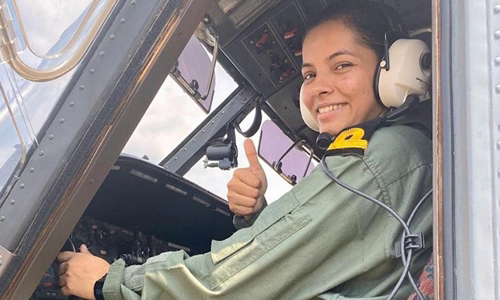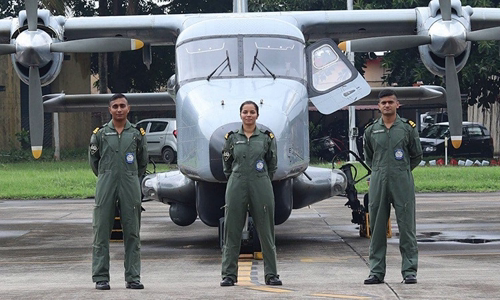2nd Lieutenant Shivangi, 24, has just entered his name in Indian naval history when he became the first female pilot of the force.
"It is a great honor and a great responsibility for all of us. I understand that I must do well," said Lieutenant Shivangi before attending the pilot badge reception and joining the air force. Indian navy on 2 December.

Lieutenant Shivangi sat in the cockpit of the Dornier aircraft Photo: CNN
Shivangi completed basic training at the Indian Naval Academy in 2018, having trained with the INAS 550 Indian Naval Air Force squadron in Kochi, southwest of Kerala state.
After joining the Indian naval air force, Shivangi was tasked with piloting the Dornier, the Indian naval transport and reconnaissance aircraft, to land on land instead of on aircraft carriers.
"We also use this aircraft for rescue, medical evacuation or similar missions when required. Therefore, I will become part of those missions," Shivangi said.
According to Lieutenant Colonel Sridhar Warrier, Indian Naval Press Press officer, the Dornier-controlled Shivangi is capable of "reconnaissance over vast expanses of sea and promptly provides information on the signs." suspicious of ships as well as other suspicious activities in the area. "
Shivangi, born and raised in the city of Muzaffarpur, east of Bihar state, said she wanted to be a pilot since she was a little girl.
"When I was 10 years old, I was staying at my grandfather's house and some ministers came here to meet the people. I went with them to my grandfather and saw a pilot controlling a helicopter. That image was inspiring. inspired me to think that I can also control one of them later, "Shivangi said.
After earning a mechanical engineering degree at Sikkim Manipal University of Technology, Shivangi went on to study for a master's degree at Malaviya National Institute of Technology in Jaipur. It was here that the door to the navy opened up to the girl when an officer arrived at her school to enroll.
"They shared with us everything about life in the navy, and all that became my motive," Shivangi said about why she decided to quit school to join the navy. .
Shivangi said naval training was not easy, but she received a lot of support from the INAS 550 squadron in Kochi.

Lieutenant Shivangi (middle) stands with two teammates in the Indian navy Photo: ANI
"Everyone supported me. I never felt like I was the only woman here, because all the squad members were always with me and guided very well," Shivangi said.
Shivangi is not the only female pilot to join the Indian armed forces. In 2016, the Indian Air Force recruited female pilots for the first time. In May, Lieutenant Bhavana Kanth became the first female pilot to be eligible to fly a fighter to carry out combat missions of the Indian Air Force.
The Indian Navy is expected to have two more female pilots on December 21. However, the three female pilots of this force, including Shivangi, will not be able to control the aircraft taking off and landing on the aircraft carrier.
"Right now, the Indian navy is still not ready for female pilots to board the aircraft carrier, because that requires some changes in the design and infrastructure on board. We need more time." , Lieutenant Colonel Warrier said. "By the time carriers are ready to host female pilots, the navy has already surpassed the previously set limits for recruiting soldiers. Later, we may recruit female soldiers in many other fields. ".
The Indian navy has allowed women to join the force decades ago, but only serves in the health sector. Since July 1992, women have been involved in various roles in the force such as air traffic control, training and training, logistics ...
"In the past, women were allowed to fight but they didn't sit directly in the cockpit. Instead, they were in charge of tactics, controlling weapons, becoming eyes and hands for pilots and machines. ". "But now things have changed when women are ready in the cockpit."
Shivangi said it was a great honor to be the first female pilot of the Indian navy but also a lot of pressure. "You know, any first person in any field carries a lot of expectations. That means there will be a lot of pressure," Shivangi said.
Indian Ministry of Defense data shows that its navy has 735 pilot positions, but currently only 644 people have been recruited. The force has more than 200 aircraft of all kinds, including MIG 29-K fighters, P-8I reconnaissance aircraft, helicopters and maritime reconnaissance aircraft.



 JamillahAl-aminFuller
JamillahAl-aminFuller







